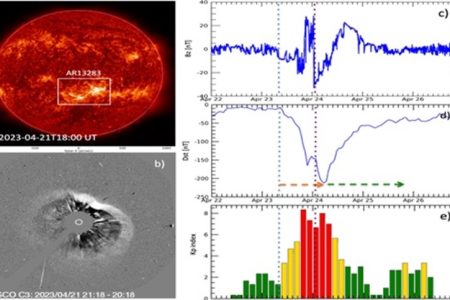New Delhi: In a spectacular celestial event, a severe geomagnetic storm graced the Earth’s magnetosphere in late-April 2023, treating observers to a mesmerizing display of the aurora visible even in lower latitudes, including Ladakh. Astronomers have meticulously traced the origins of this extraordinary event back to the Sun, utilizing multiwavelength observations from various space telescopes.
The cause behind this intense solar storm was identified as the rotation of a filament structure near the Sun. Coronal mass ejections (CMEs), propelled by the Sun’s ejection of ionized gas and magnetic fields, encounter planets like Earth, leading to significant magnetic storms. Understanding and predicting these CMEs hold both scientific and practical importance, as they can impact human technology on Earth and in space.
The triggering event was a large-scale CME eruption originating from ‘Active Region 13283′ near the solar disk center on April 21, 2023. This event resulted in the most intense geomagnetic storm of solar cycle 25. Launched at a speed of approximately 1500 km/s, the CME encountered Earth’s environment on April 23, leading to a geomagnetic storm classified as “G4 severe.”
Dr. P. Vemareddy, the author of the study conducted by the Indian Institute of Astrophysics, noted the surprising intensity of the storm given its launch from a weak magnetic field region on the Sun. The study reveals that the energization process was unexpectedly rapid, and the formation of twisted magnetic flux was considered unlikely.
The study indicates that the CME’s association with a pre-existing magnetized plasma filament in the source active region on the Sun played a crucial role. The magnetic fields evolved with changing helicity sign a few hours before the eruption, destabilizing the magnetic field equilibrium in the solar atmosphere.
For a CME to be geoeffective, the magnetic fields must be directed southward concerning Earth’s magnetic field. During this particular eruption, the CME structure exhibited a rare rotation of about 56 degrees in a clockwise direction due to magnetic forces. This rotation caused the CME’s magnetic fields to orient dominantly southward, leading to the most intense storm of solar cycle 25.
The findings underscore the importance of comprehending CMEs’ complete picture, including their magnetic structure, origin mechanisms, evolution, and propagation from the Sun to Earth. Researchers anticipate leveraging observations from the recently launched space observatory Aditya-L1 to enhance understanding, particularly with imaging observations close to the Sun provided by the Visible Emission Line Coronagraph (VELC) payload developed by the Indian Institute of Astrophysics.
The celestial ballet of the aurora, sparked by the intricate dance of solar forces, serves as a reminder of the profound connections between our Earth and the Sun.

